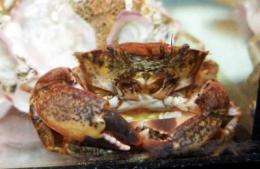A new invading sea crab reaches the Ebro Delta

Originally endemic to the Atlantic Coast of North America, over the past 30 years Dyspanopeus sayi has been involuntarily introduced in the UK, France, the Netherlands, the Black Sea and the Adriatic Sea. A study shows that in recent years the sea crab has established itself along the Western Mediterranean Coast.
A team of Spanish and German researchers have recorded the first American Dyspanopeus sayi sea crab in the bay of Els Alfacs in the Ebro Delta (Spain). Both sexes were captured along with many ovigerous females (carrying eggs) in different areas and different times. This way, it was confirmed that as a species they are well established and reproduce along the Western Mediterranean coast without problems.
This new invading crab is endemic to the North-East coast of North America stretching from Canada to Florida. In the last few decades it has reached the UK, France, the Netherlands, the Black Sea and the Adriatic Sea and can now be seen in the westernmost part of the Mediterranean. Researchers are juggling with various hypotheses on their invasion.
"It would have been very difficult for them to arrive to Europe on their own without human involvement. They could have arrived at the Ebro Delta on sea transport or other trade exchanges," as outlined to SINC by Guillermo Guerao, co-author of the study that has been published in the Scientia Marina journal and researcher at Spain's Food and Agriculture Research and Technology Institute (IRTA).
Another possibility is that a few specimens reached the Western Mediterranean from the population in Italy. We would then be looking at a secondary introduction. "But to get more information we would need to carry out an extensive genetics study on the different native and non-native Dyspanopeus sayi populations," adds Guerao.
According to the study, the first identified specimens were captured by hand while researchers were gathering Carcinus aestuarii, the native crab species very abundant in the Ebro Delta. They also appeared in the bay of Els Alfacs amongst the catches of small-scale fisherman from Sant Carles de la Ràpita (Tarragona).
A potential danger for the native fauna
"Dyspanopeus sayi is a species that can withstand temperature and salinity changes very well. It can therefore colonise shallow coastal areas (as shallow as 46 metres) and, more specifically, estuaries," explains the biologist from IRTA. It does not live in fresh water. Therefore, in the Ebro Delta they have only been found in the bay of Els Alfacs and it has not yet been confirmed whether they are present in the bay of Fangar.
This species of sea crab has a marked sexual dimorphism: the males are bigger than the females. The crabs feed on bivalve molluscs like mussels and clams and they use their strong claws to break shells. As predators they hunt at dusk or in the darkness.
Up until now the researchers have not detected any significant effect on the native fauna of the bay of Els Alfacs but monitoring with regular sampling in the area has not yet been carried out to confirm this.
However, as Guerao states, "considering their diet (bivalve molluscs) and the effect that this species has had in other places (in the Adriatic Sea it has exterminated some species like the Mytilus galloprovincialis mussel and the Ostrea edulis oyster) it would be interesting to regularly monitor the dynamic of Dyspanopeus sayi in the Ebro Delta."
More information: Schubart, Christoph D.; Guerao, Guillermo; Abello, Pere. "First record and evidence of an established population of the North American mud crab Dyspanopeus sayi (Brachyura: Heterotremata: Panopeidae) in the western Mediterranean" Scientia Marina 76(1): 79-85 DOI: 10.3989/scimar.03361.16ª, 2012.




















